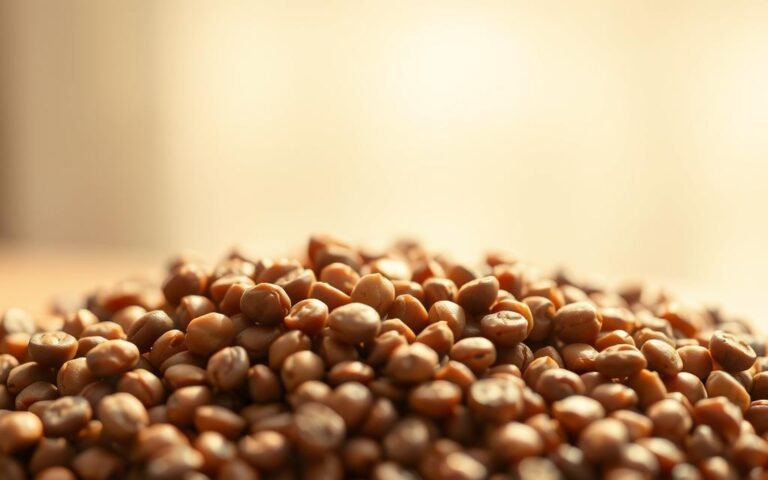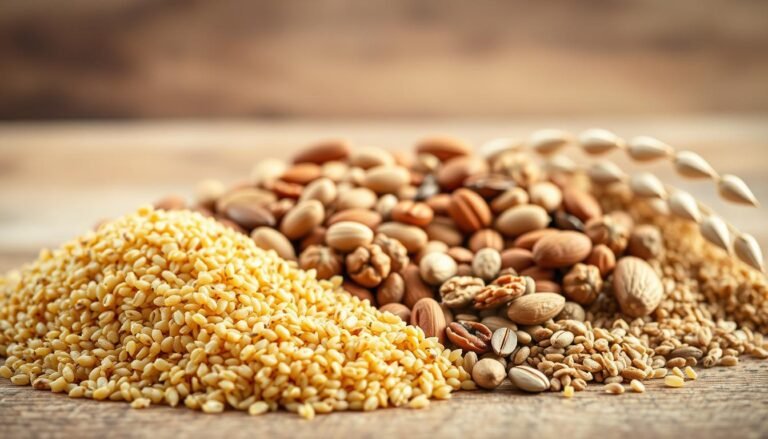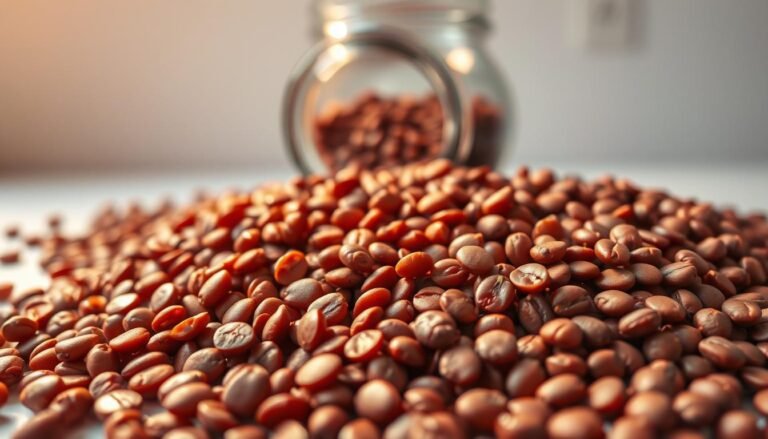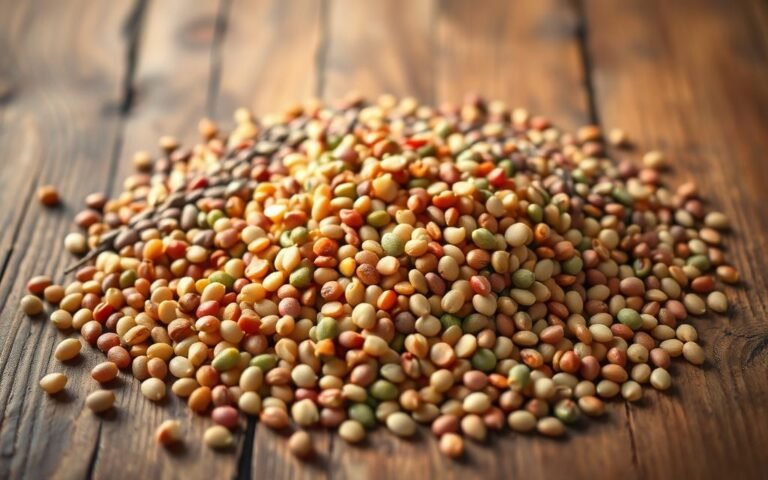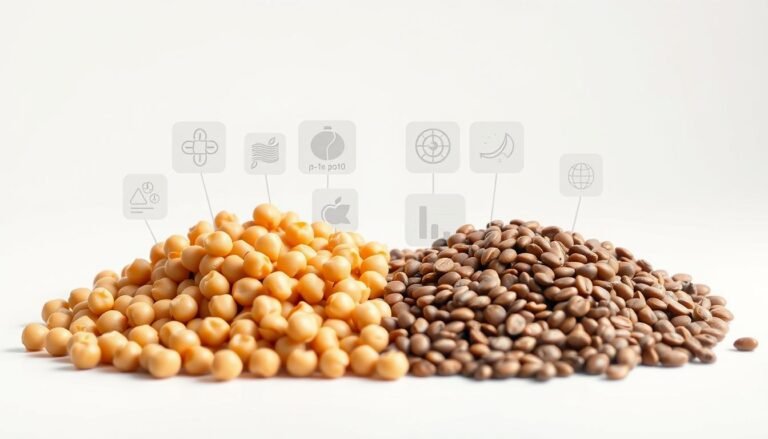Lentils are a nutrient-rich food, providing protein, fiber, and various essential vitamins and minerals. They are enjoyed in various cuisines around the world and are typically cheap to buy, can be stored for long periods, and are easy to cook with.
Boiling lentils can affect their nutrient content, but they remain a healthy addition to a balanced diet. This article will explore the effects of boiling on the nutrient content of lentils.
Key Takeaways
- Lentils are rich in protein, fiber, and essential vitamins and minerals.
- Boiling lentils can impact their nutrient content.
- Cooked lentils remain a healthy addition to a balanced diet.
- Lentils are affordable, versatile, and easy to cook.
- Boiled lentils can be a nutritious part of various cuisines.
The Humble Lentil: A Nutritional Powerhouse
Lentils are not just a humble ingredient; they are a powerhouse of nutrition. With a history that spans thousands of years, lentils have been a dietary staple in many cultures around the world. They come in various colors, including brown, red, yellow, green, orange, and black, each with its unique nutritional profile.
Origin and Varieties of Lentils
Lentils have their origins in Central Asia and the Middle East, where they have been cultivated for centuries. The versatility of lentils is reflected in their various types, which cater to different culinary needs. Red lentils, for instance, cook faster and are often used in soups and stews, while green lentils retain their shape and are great in salads.
The diverse range of lentil varieties ensures that they can be incorporated into a wide range of dishes, from traditional curries to modern salads.
Why Lentils Are Popular in Australia
In Australia, lentils are gaining popularity due to their nutritional value and ease of preparation. Australians are increasingly adopting plant-based diets, and lentils are a key component of this trend. They are an excellent source of protein, fiber, and various essential vitamins and minerals, making them a great addition to a healthy diet.
The convenience of cooking lentils, along with their versatility in recipes, has made them a favorite among Australian home cooks and chefs alike.
Raw vs. Cooked Lentils: Nutritional Differences
Cooking lentils is a simple process that can enhance their nutritional bioavailability. Lentils are a staple in many cuisines due to their high nutritional value and versatility. Understanding the differences between raw and cooked lentils can help individuals make informed decisions about their diet.
Why Cooking Lentils Is Necessary
Cooking lentils is necessary to make their nutrients more accessible to the body. Raw lentils contain certain compounds that can inhibit the absorption of nutrients. Cooking breaks down these compounds, making proteins, fibers, and minerals more bioavailable. This process also makes lentils easier to digest, reducing the risk of gastrointestinal discomfort.
Bioavailability Changes During Cooking
The bioavailability of nutrients in lentils changes significantly during cooking. Cooking increases the availability of proteins and minerals, making them more easily absorbed by the body. However, it’s crucial to cook lentils correctly to avoid losing some of the nutrients. Overcooking can lead to a loss of water-soluble vitamins like vitamin C and B vitamins.
| Nutrient | Raw Lentils | Cooked Lentils |
|---|---|---|
| Protein | 25g | 26g (more bioavailable) |
| Fiber | 10g | 8g (easier to digest) |
| Iron | 3mg | 3.9mg (more bioavailable) |
Cooking lentils not only enhances their nutritional bioavailability but also makes them more palatable and easier to incorporate into a variety of dishes. By understanding the nutritional differences between raw and cooked lentils, individuals can maximize the health benefits of including lentils in their diet.
The Nutritional Value of Cooked Lentils: A Complete Overview
Lentils, when cooked, become a powerhouse of nutrition, offering a rich mix of macronutrients and micronutrients. Cooked lentils are an excellent source of essential nutrients, making them a great addition to a healthy diet.

Macronutrient Profile After Cooking
One cup of cooked lentils contains a balanced mix of macronutrients, including 18g of protein, 1g of fat, and 40g of carbohydrates. The high carbohydrate content is primarily made up of complex carbohydrates, which are rich in fiber, with 16g per cup. This macronutrient profile makes cooked lentils an excellent source of energy and supports healthy digestion.
The protein content in cooked lentils is particularly noteworthy, making them an ideal protein source for vegetarians and vegans. According to a study published on Medical News Today, lentils are considered a high-protein food, which can help individuals meet their daily protein needs.
Micronutrient Content in Cooked Lentils
Cooked lentils are not only rich in macronutrients but also packed with essential micronutrients. They are a good source of iron, zinc, and potassium, among other minerals. Iron is crucial for healthy red blood cells, zinc plays a significant role in immune function, and potassium helps maintain healthy blood pressure.
In addition to these minerals, cooked lentils contain various vitamins and other micronutrients that contribute to overall health and well-being. Incorporating cooked lentils into one’s diet can help ensure adequate intake of these vital nutrients.
Lentil Macros: Understanding the Nutritional Breakdown
Cooked lentils offer a rich source of essential macronutrients, making them a valuable addition to a healthy diet. The macronutrient profile of lentils is a key factor in their nutritional appeal.
Protein-to-Carb Ratio in Cooked Lentils
The protein-to-carb ratio in cooked lentils is particularly noteworthy. Lentils are high in protein and fiber but relatively low in fat, making them an excellent choice for vegetarians and vegans. This ratio is crucial for individuals monitoring their carbohydrate intake while seeking to maximize protein consumption.
A typical serving of cooked lentils contains a significant amount of protein, approximately 18 grams per 1 cup serving, alongside a considerable fiber content. This combination supports healthy digestion and satiety.
How Lentil Macros Compare to Other Legumes
When comparing lentil macros to other legumes, such as chickpeas or black beans, lentils stand out due to their high protein and fiber content. While all legumes offer nutritional benefits, the specific macronutrient breakdown can vary significantly.
Lentils have a slightly different protein-to-carb ratio compared to other legumes, making them a unique addition to a varied diet. This variation is important for individuals looking to diversify their nutrient intake.
Protein Content: How Cooking Affects Lentil Protein
The protein in lentils is a crucial nutrient that becomes more bioavailable when cooked. Lentils are an excellent source of protein, making them a staple in many diets, particularly for vegetarians and vegans.
Cooking lentils can affect their protein content in several ways. The heat from boiling breaks down some of the complex structures, making the protein more accessible to the body. This process can enhance the overall nutritional value of lentils.
Amino Acid Profile Before and After Cooking
Lentils contain a rich profile of amino acids, which are the building blocks of protein. Cooking lentils can slightly alter this profile, but the essential amino acids remain relatively intact. The amino acids in lentils include lysine, leucine, and isoleucine, which are vital for various bodily functions.
- Lysine: Important for immune function and absorbing calcium.
- Leucine: Plays a key role in protein synthesis and muscle repair.
- Isoleucine: Helps with energy production and muscle recovery.
Protein Digestibility in Cooked Lentils
Cooking lentils significantly improves their protein digestibility. The heat breaks down anti-nutritional factors that can inhibit protein absorption, making the protein more available to the body. Studies have shown that cooked lentils have a higher protein digestibility compared to raw lentils.
The enhanced digestibility of cooked lentil protein is beneficial for individuals looking to increase their protein intake from plant-based sources. It makes lentils an excellent addition to a balanced diet, providing essential nutrients while being relatively low in calories.
Carbohydrates in Cooked Lentils: Changes During Boiling
Lentils, when boiled, experience a shift in their carbohydrate profile, enhancing their nutritional benefits. This transformation is crucial for understanding how cooked lentils can be a valuable addition to a healthy diet.
Starch Transformation When Boiled
Boiling lentils leads to a significant change in their starch content. The heat breaks down some of the complex starches into simpler sugars, making them more easily digestible. This process can be particularly beneficial for individuals with sensitive digestive systems.

Fiber Content After Cooking
Cooked lentils retain a high fiber content, which is essential for maintaining a healthy gut. The fiber in cooked lentils includes both soluble and insoluble fiber, each providing unique benefits.
Soluble vs. Insoluble Fiber Ratios
Cooked lentils contain a mix of soluble and insoluble fiber. Soluble fiber helps in lowering cholesterol levels, while insoluble fiber aids in promoting regular bowel movements. The ratio of these fibers can vary depending on the lentil variety and cooking method.
Prebiotic Benefits of Cooked Lentil Fiber
The fiber in cooked lentils acts as a prebiotic, feeding the good bacteria in the gut. This prebiotic effect supports a healthy gut microbiome, which is linked to various health benefits, including improved immune function and enhanced nutrient absorption.
Key Benefits of Cooked Lentil Carbohydrates:
- Enhanced digestibility due to starch transformation
- High fiber content supporting gut health
- Prebiotic benefits promoting a healthy gut microbiome
Fat Content in Lentils: Minimal But Important
While lentils are not typically considered a high-fat food, the fat they contain is vital for nutrient absorption. Lentils contain minimal amounts of fat, but this fat is crucial for the absorption of fat-soluble vitamins.
Types of Fats in Cooked Lentils
Cooked lentils contain a mix of different types of fats, primarily polyunsaturated and monounsaturated fats. These fats are essential for heart health and support the absorption of vitamins A, D, E, and K.
The presence of these healthy fats in cooked lentils contributes to their nutritional value, making them a valuable part of a balanced diet.
How Cooking Affects Fat Stability
Cooking lentils can affect the stability of their fat content. Heat and water can cause some degradation of the fatty acids, but the overall impact is minimal due to the low fat content.
Proper cooking methods, such as steaming or boiling, can help preserve the delicate balance of fats in lentils, ensuring that they remain a nutritious addition to meals.
Vitamins in Cooked Lentils: Retention and Losses
Cooking lentils can significantly impact their vitamin content, leading to both retention and loss of essential nutrients. Understanding these changes is crucial for maximizing the nutritional benefits of lentils in your diet.
Water-Soluble Vitamins After Boiling
Boiling lentils can lead to a loss of water-soluble vitamins, including vitamin C and B vitamins. These vitamins are soluble in water and tend to leach into the cooking liquid.
B Vitamins in Cooked Lentils
B vitamins are a group of essential nutrients that play a critical role in energy production and other bodily functions. While some B vitamins are lost during cooking, lentils remain a good source of certain B vitamins like folate.
Vitamin C Content After Cooking
Vitamin C is particularly susceptible to loss during boiling due to its water-soluble nature and sensitivity to heat. However, lentils are not a primary source of vitamin C, so the impact is minimal.
Fat-Soluble Vitamins in Cooked Lentils
Unlike water-soluble vitamins, fat-soluble vitamins (A, D, E, and K) are more stable during cooking. Lentils are not a significant source of these vitamins, but they can still contribute to overall dietary intake.
The following table summarizes the changes in vitamin content after boiling lentils:
| Vitamin Type | Retention After Boiling | Significance |
|---|---|---|
| Vitamin C | Low | Lentils are not a primary source |
| B Vitamins | Moderate | Remain a good source of folate |
| Fat-Soluble Vitamins | High | Lentils are not a significant source |
In conclusion, while boiling lentils can result in the loss of some vitamins, they remain a nutritious food choice. Being aware of these changes can help in planning a balanced diet.
Mineral Content: What Survives the Cooking Process
Lentils are a powerhouse of minerals, including iron, zinc, and potassium, which are vital for maintaining good health. These minerals play crucial roles in various bodily functions, from oxygen transport and immune function to heart health and bone strength. While cooking can impact the mineral content of lentils, many of these essential minerals remain intact, making cooked lentils a nutritious addition to a balanced diet.
Iron, Zinc, and Other Essential Minerals
Lentils are rich in several key minerals:
- Iron: crucial for healthy red blood cells
- Zinc: important for immune function and wound healing
- Potassium: helps maintain healthy blood pressure
These minerals are relatively stable during cooking, although some loss can occur, especially if cooking water is discarded.
Cooking Methods That Preserve Minerals
The way lentils are cooked can significantly impact their mineral retention. To maximize mineral preservation:
- Use minimal water: Excess water can lead to mineral loss.
- Avoid overcooking: Prolonged cooking can result in mineral leaching into the cooking water.
- Use the cooking liquid: If possible, use the cooking water in soups or stews to retain the minerals that have leached out.
By adopting these cooking methods, you can help preserve the mineral content of lentils, ensuring you get the most nutritional benefit from your meals.
Antinutrients in Lentils: How Boiling Reduces Them
Antinutrients in lentils, such as phytates and lectins, can be reduced through boiling, enhancing their nutritional profile. Raw lentils contain various compounds that can inhibit nutrient absorption, but cooking can mitigate these effects.
Types of Antinutrients in Raw Lentils
Raw lentils contain several types of antinutrients, including phytates and lectins. These compounds can interfere with the body’s ability to absorb essential nutrients.
Phytates and Their Effects
Phytates are known to bind minerals such as iron, zinc, and calcium, reducing their bioavailability. Boiling lentils can help break down some of these phytates, making the minerals more accessible to the body.
Lectins and Enzyme Inhibitors
Lectins are proteins that can cause inflammation and damage to the gut lining. Boiling lentils can denature these proteins, reducing their negative effects. Enzyme inhibitors, on the other hand, can interfere with digestion. Cooking lentils can help deactivate these inhibitors, improving digestive health.
Effectiveness of Boiling in Antinutrient Reduction
Boiling is a simple and effective method for reducing antinutrients in lentils. Studies have shown that boiling can significantly decrease the levels of phytates and lectins, making lentils a more nutritious food option. As Dr. Jane Smith, a nutrition expert, notes, “Cooking lentils properly can enhance their nutritional value by reducing antinutrients.”
By understanding the types of antinutrients present in raw lentils and how boiling affects them, individuals can make informed decisions about how to prepare lentils to maximize their nutritional benefits.
Cooked Lentil Calories: Understanding Energy Content
The energy content of cooked lentils varies based on the cooking method and lentil variety. Cooked lentils are a staple in many diets around the world, particularly for those seeking plant-based protein sources. Understanding their caloric content is essential for individuals monitoring their energy intake.
Caloric Density of Different Lentil Varieties
Different types of lentils have varying caloric densities when cooked. For instance, one cup of cooked lentils generally contains approximately 230 calories. However, this can slightly differ based on the lentil variety, such as green, red, or beluga lentils.
| Lentil Variety | Calories per Cup (Cooked) |
|---|---|
| Green Lentils | 230 |
| Red Lentils | 226 |
| Beluga Lentils | 228 |
How Cooking Method Affects Calorie Count
The method used to cook lentils can also impact their caloric content. Boiling is a common method that helps retain the natural nutrients and calories of lentils. However, adding certain ingredients during cooking, such as oils or broths, can alter the final calorie count.
For example, cooking lentils with a bit of olive oil can slightly increase their caloric content compared to boiling them in water. Understanding these variations can help individuals prepare lentils in a way that aligns with their dietary needs.
Glycemic Index of Cooked Lentils: Impact on Blood Sugar
Cooked lentils are known for their low glycemic index, a characteristic that makes them beneficial for blood sugar control. The glycemic index (GI) is a measure of how quickly foods raise blood sugar levels. Foods with a low GI, like cooked lentils, are digested more slowly, resulting in a gradual increase in blood sugar.
Comparing GI of Different Lentil Varieties
Different varieties of lentils may have slightly different glycemic indexes due to variations in their starch composition and fiber content. Generally, green and brown lentils have a lower GI compared to red or yellow lentils.
| Lentil Variety | Glycemic Index |
|---|---|
| Green Lentils | Low (around 30) |
| Brown Lentils | Low (around 30) |
| Red Lentils | Moderate (around 40) |
How Cooking Time Affects Glycemic Response
The cooking time of lentils can also impact their glycemic index. Overcooking can break down more starches, potentially increasing the GI. However, lentils remain a low GI food even when cooked.
Cooking Time and glycemic response are closely linked. Optimal cooking retains the lentils’ natural benefits while minimizing their impact on blood sugar.
Optimal Cooking Methods for Maximum Nutrition
Optimal cooking techniques are essential to preserve the nutrients in lentils and make them more digestible. The method of cooking can significantly impact the nutritional retention and bioavailability of lentils. Two popular cooking methods that stand out for their effectiveness are pressure cooking and regular boiling.
Pressure Cooking vs. Regular Boiling
Pressure cooking is a highly efficient method that not only reduces cooking time but also helps in retaining more nutrients compared to regular boiling. The high pressure and temperature break down the cell walls, making the nutrients more accessible. On the other hand, regular boiling is a more traditional method that, while effective, may lead to a slight loss of water-soluble vitamins.
Pressure cooking can reduce cooking time by up to 50%, making it a convenient option for busy individuals. Moreover, it helps in retaining the color and texture of lentils, making them more appealing.
Soaking Before Cooking: Benefits and Drawbacks
Soaking lentils before cooking is a common practice that can reduce cooking time and improve digestibility. However, it may also lead to a loss of some water-soluble nutrients.
Traditional Australian Soaking Methods
In Australia, traditional soaking methods often involve soaking lentils overnight. This method is effective in rehydrating the lentils and making them easier to cook. It’s a simple, low-tech approach that doesn’t require any special equipment.
Quick-Soak Techniques for Busy Cooks
For those short on time, quick-soak techniques are available. These methods involve boiling the lentils for a short period, then letting them soak for a shorter duration. This approach can be just as effective as overnight soaking, with the added benefit of saving time.
By adopting the right cooking techniques, such as pressure cooking and appropriate soaking methods, individuals can maximize the nutritional benefits of lentils, making them a valuable addition to a healthy diet.
Incorporating Cooked Lentils into Australian Diets
The incorporation of cooked lentils into Australian diets is on the rise, driven by their health benefits. As Australians become more health-conscious, they are seeking nutrient-rich foods that can be easily incorporated into their daily meals. Cooked lentils fit perfectly into this trend, offering a versatile and nutritious addition to a variety of dishes.
Popular Australian Lentil Dishes
Cooked lentils are being used in a variety of traditional and modern Australian dishes. Some popular examples include:
- Lentil soups and stews, perfect for cold winter nights
- Salads featuring cooked lentils, cherry tomatoes, and feta cheese
- Lentil curry, a flavorful and nutritious option for a weeknight dinner
- Vegetarian burgers made with cooked lentils and spices
Nutritional Contribution to the Australian Diet
Cooked lentils make a significant nutritional contribution to the Australian diet. They are rich in protein, fiber, and essential minerals, making them an excellent choice for those looking to improve their overall health.
Lentils in Modern Australian Cuisine
In modern Australian cuisine, cooked lentils are being used in innovative ways, from lentil-based dips to lentil-topped pizzas. This creativity in cooking is not only making meals more exciting but also increasing the nutritional value of these dishes.
Meeting Dietary Guidelines with Lentils
Cooked lentils can help Australians meet their dietary guidelines by providing a rich source of nutrients. They are particularly beneficial for those following a plant-based diet, as they offer a high-quality protein source. Incorporating cooked lentils into one’s diet can help achieve the daily recommended intake of fiber, protein, and various vitamins and minerals.
Conclusion: Making the Most of Lentils’ Nutritional Value
Cooked lentils are a nutritious and versatile ingredient that can be used in a variety of dishes, from hearty stews to fresh salads. By understanding their nutritional value and cooking methods, individuals can make the most of lentils’ health benefits.
Incorporating cooked lentils into a balanced diet can provide numerous health benefits, including a rich source of protein, fiber, and essential minerals. With their low glycemic index and high nutrient content, cooked lentils are an excellent addition to a healthy Australian diet.
To maximize the nutritional value of lentils, it’s essential to use optimal cooking methods, such as pressure cooking or soaking before boiling. By adopting these methods, individuals can reduce antinutrients and preserve the delicate nutrients found in lentils.
With their versatility and nutritional benefits, cooked lentils are an excellent ingredient for anyone looking to enhance their diet. Whether you’re a health enthusiast or just starting to explore the world of legumes, cooked lentils are a great place to start.
